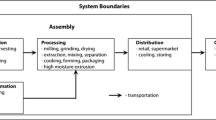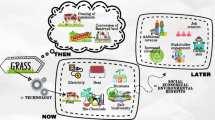Abstract
The profitability in organic and conventional milk production systems when using three different dietary proportions (51 %, 62 % and 69 % of dry matter) of high-quality grass silage to dairy cows was calculated. Feed intake and milk production data were measured in a dairy cow experiment in which the same types of feeds were used over the entire lactation, but the proportion of forage was increased to three different degrees in the diet. The results of the economic analyses showed that full cost coverage was only reached within the organic production system and that a large herd size (160 cows) was required to achieve economically sustainable dairy production. However, large herd size required large pasture areas in organic production, which can be difficult to achieve in forest-dominated districts. The results of the calculated profitability showed that it was profitable to increase the average dietary proportion of high-quality silage from 51 % to 62 % of dry matter in conventional production with concentrate and grain prices at their current high levels. In organic production, there were only minor differences in calculated profitability between providing the obligatory 60 % and 69 % of dry matter as high-quality silage in the dairy cow diet.




Similar content being viewed by others
References
Arla Foods (2012) Calculations of the milk price based on Arla Foods spreadsheet, SEK. www.arlafoods.se/upload/global/prisberegner/afregn_maelkepris_se_version%20100202.xls. Accessed 5 June 2012
Agriwise (2012) Regional Enterprise Budgets. Swedish University of Agricultural Sciences, Department of Economics. (in Swedish), Uppsala, Sweden
Beever DE, Doyle PT (2007) Feed conversion efficiency as a key determinant of dairy herd performance: a review. Aust J Exp Agric 47(6):645–657
Danmarks Jordbrugsforskning (2004) DRIFT 2004. (in Danish). www.landbrugsinfo.dk/Itvaerktoejer/Maskiner-og-arbejde/Sider/Beregn_arbejdsbehovet_ved_markarbejde_me.aspx. Accessed 8 June 2012
EC (2008) European Commission Regulation (EC) No 889/2008 of the 5 September 2008 laying down detailed rules for the implementation of Council Regulation (EC) No 834/2007 on organic production and labelling of organic products with regard to organic production, labelling and control. Official Journal of the European Union 1892008, Brussels, Belgium
EC (2011) European Commission EU dairy farms report 2011—based on FADN data. Brussels, Belgium
Emanuelson M, Cederberg C, Bertilsson J, Rietz H (2006) Närodlat foder till mjölkkor—en kunskapsuppdatering. Near farm cultivated feeds for dairy cows—a knowledge update. Rapport nr 7059-P. (in Swedish), Swedish Dairy Association, Stockholm, Sweden
Ericson, L (2011) Norrländsk Växtodling 2011. Crop production in Northern Sweden 2011. Department of Agricultural Reseach for Northern Sweden. Swedish University of Agricultural Sciences, Forslundagymnasiet Umeå and Lantbrukarnas Riksförbund (LRF). (in Swedish), Umeå, Sweden
Hansson H (2007) The links between management's critical success factors and farm level economic performance on dairy farms in Sweden. Acta Agric Scand C Food Econ 4(2):77–88
Hansson H (2008) Are larger farms more efficient? A farm level study of the relationships between efficiency and size on specialized dairy farms in Sweden. Agr Food Sci 17(4):325–337
Kottek M, Grieser J, Beck C, Rudolf B, Rubel F (2006) World map of the Koppen–Geiger climate classification updated. Meteorol Z 15(3):259–263
KRAV (2008) Regler för KRAV-certifierad produktion januari 2008. Standards for KRAV-certified production January 2008. (in Swedish), KRAV, Uppsala, Sweden
KRAV (2012) Regler för KRAV-certifierad produktion utgåva 2012. Standards for KRAV-certified production 2012. (in Swedish), KRAV, Uppsala, Sweden
Marston SP, Clark GW, Anderson GW, Kersbergen RJ, Lunak M, Marcinkowski DP, Murphy MR, Schwab CG, Erickson PS (2011) Maximizing profit on New England organic dairy farms: an economic comparison of 4 total mixed rations for organic Holsteins and Jerseys. J Dairy Sci 94(6):3184–3201
Maskinkalkylgruppen (2011) Maskinkostnader 2011 : underlag och kalkylexempel för lantbruksmaskiner. Machinery costs 2011: data and spreadsheets for agricultural machinery. (in Swedish), Maskinkalkylgruppen & HIR Malmöhus, Malmö, Sweden
Official Statistics of Sweden (2011) Standard yields for yield survey districts, counties and the whole country in 2011. JO 15 SM 1101 JO 15 Standard yields. Statistics Sweden, Stockholm
Patel M (2012) Effects of increasing the proportion of high-quality grass silage in the diet of dairy cows. Dissertation, Swedish University of Agricultural Sciences
SFS (1988) Swedish Animal Welfare Ordinance 1988:539, section 10. Stockholm, Sweden
Spörndly E, Kumm K-I (2010) Lönar det sig med mer ensilage och bete till korna?—Ekonomiska beräkningar på gårdsnivå. Is it profitable to use more silage and pasture to the dairy cows?—Economic calculations on farm level. Rapport 275. (in Swedish), Swedish University of Agricultural Sciences, Department of Animal Nutrition and Management, Uppsala, Sweden
Spörndly R (2003) Fodertabeller för idisslare. Feed tables for ruminants. Rapport 257. (in Swedish), Swedish University of Agricultural Sciences, Department of Animal Nutrition and Management, Uppsala, Sweden
Sundberg T, Berglund B, Rydhmer L, Strandberg E (2009) Fertility, somatic cell count and milk production in Swedish organic and conventional dairy herds. Livest Sci 126(1–3):176–182
Swedish Board of Agriculture (2007) Jordbrukets miljöeffekter 2020—en framtidsstudie. Agriculture's environmental impact by 2020—a prospective study. (in Swedish), Swedish Board of Agriculture, Jönköping, Sweden
Swedish Board of Agriculture (2009) Jordbruk, bioenergi och miljö. Agriculture, bioenergy and the environment. Report 2009:22. (in Swedish), Swedish Board of Agriculture, Jönköping, Sweden
Swedish Board of Agriculture (2010) Föreskrifter och allmänna råd om djurhållning inom lantbruket. Regulations and guidelines of animal husbandry and agriculture. SJVFS 2010:15 Saknr L100. (in Swedish), Swedish Board of Agriculture, Jönköping, Sweden
Swedish Board of Agriculture (2012a) Holdings with organic milk production and number of cattle of different sorts at these in June 2011 by size of herd. Table 1.5a. Statistics report 2012:03. Swedish Board of Agriculture, Jönköping, Sweden
Swedish Board of Agriculture (2012b) Support for agriculture. (in Swedish), Swedish Board of Agriculture, Jönköping, Sweden. www.jordbruksverket.se/amnesomraden/stod.4.5abb9acc11c89b20e9e8000401.html. Accessed 15 June 2012
Swedish Dairy Association (2012a) Dairy statistics 2011. Swedish Dairy Association, Stockholm, Sweden
Swedish Dairy Association (2012b) Mjölkekonomirapport 2, Juni. Dairy farms economics report 2, June 2012. (in Swedish), Swedish Dairy Association, Stockholm, Sweden
Wilson P (2011) Decomposing variation in dairy profitability: the impact of output, inputs, prices, labour and management. J Agric Sci 149:507–517
Acknowledgements
This study was funded by FORMAS—the Swedish Research Council for Environment, Agricultural Sciences and Spatial Planning and the Swedish Board of Agriculture.
Author information
Authors and Affiliations
Corresponding author
Rights and permissions
About this article
Cite this article
Patel, M., Wredle, E., Spörndly, E. et al. Profitability of organic and conventional dairy production with different dietary proportions of high-quality grass silage. Org. Agr. 3, 31–39 (2013). https://doi.org/10.1007/s13165-013-0043-1
Received:
Accepted:
Published:
Issue Date:
DOI: https://doi.org/10.1007/s13165-013-0043-1




